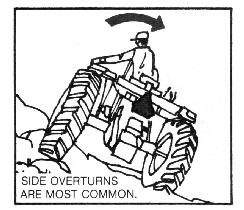
Farm tractor accidents are the major cause of farm work-related deaths. More than 200 Indiana farm family members died as the result of tractor accidents during the 70's. Nationally, it is estimated that between 500 and 600 persons are killed each year in tractor accidents; and, for every person killed, at least 40 others are injured.
Tractor upsets or overturns account for more than half of all tractor-related deaths. Falls are also a major cause of tractor accidents. Falls involve both tractor operators and extra riders who are often children. Another source of tractor-related injuries and death is entanglement in rotating power-takeoff components.

Examples of some typical fatal tractor accidents are:
These are only a few examples of the tragedies caused by unsafe use of farm tractors. Most tractor accidents happen during peak cropping months, from April through October. Most tractor accidents happen to persons aged 25-64; but operators under 15 and over 64 have 7 to 10 times more accidents per hour of machine use than operators in the 25-64 age group.(National Safety council. Accident Facts, 1978)
More than 85 percent of all tractor accidents involve members of the farm family. Of course, in many situations, members of the family do most of the tractor work. However, few tractor operators, family or otherwise, have had training for the job of tractor operation.
A vitally important tractor safety rule is to be sure that each person who operates a tractor is trained, physically fit, and qualified to do the job.
The new tractor operator should first practice, without equipment attached, in a level field or a large, level yard. A skilled operator should be the trainer. The trainer should start the tractor, demonstrating the procedure for the new operator. The trainer should drive the tractor around the yard, showing the student how each of the controls operate. Then, the new operator can take the seat and operate the tractor, while the trainer stands on the drawbar to give assistance if needed.
If your tractor is equipped with a cab, the trainer will need to ride in the cab to give needed instruction. Normally, extra riders should not be allowed anywhere on the tractor. The hazard is not so great during the training, since the tractor is operating on level ground at slow speed without attached equipment.
After the new operator has learned to operate the tractor alone in a level area, the next step is to attach and operate the equipment. The trainer should now stay off the tractor. The new operator should gradually work into the more complex jobs of tractor operation.
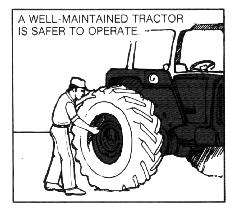
Many factors affect the reliability and safety of your tractor. Safe operation begins with making a pre-operational check before each tractor use. Keeping the tractor in good repair is an important part of safety.
Before starting the tractor, check:
Your tractor operator's manual is an important safety manual. Read it, know and understand the information in it. Follow all operating precautions and the recommendations outlined in the manual.
Before starting the tractor, make one more check-of your clothing. Loose, torn, or bulky clothing can catch on moving parts, pedals, or levers. Clothing should fit well and be in good repair. Your shoes or boots should be in good condition and have slip-resistant soles. Laces should be tightly tied and not extend out beyond the shoe. Long hair should be tied back or kept under a hat.
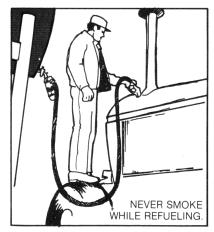
Prevent fires and explosions when refueling. The greatest danger occurs when handling gasoline, gasohol, or LP-gas, because these fuels vaporize easily to form explosive mixtures.
Never refuel your tractor while the engine is running or is hot. Static electricity, a spark from the ignition system, or a hot exhaust could cause the fuel to ignite. Grounding out the tractor by use of a ground wire or by dropping mounted equipment so it touches the ground can reduce static electricity.
Always refuel your tractor outside. Locate large storage tanks at least 40 feet from any building. Keep the storage area free from weeds and other easily ignited materials. Label your fuel containers so that they can be identified quickly and accurately. Carry gasoline and diesel fuel in approved safety cans. Approved cans bear Underwriters Laboratories or Factory Mutual labels. Never smoke while refueling.
Carry a first aid kit and an approved ABC-type dry chemical extinguisher. Every tractor should have at least one 5-pound extinguisher.
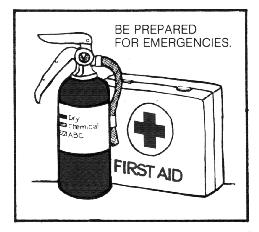
More and more farmers are recognizing the safety, comfort and utility of a cab. A cab built around a crush-resistant protective frame will give protection from overturns, dust, weather, and will reduce fatigue. It should also be designed to keep noise at a safe level. A roll-over protective structure (HOPS) and seat belts can save your life.
A pressurized air-filtering and air-conditioning system is another comfort factor. However, cabs do not protect against chemical fumes such as those from pesticides, unless very specialized equipment is installed.
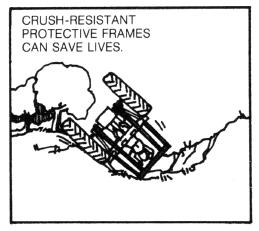
An unshielded or partially-shielded stub shaft can be deadly to the careless or unsuspecting operator. It can catch clothing or a loose shoestring and wrap a person around it in a fraction of a second. Keep the stub shaft guarded when not in use to provide power to other implements. There are two types of PTO stub shaft shields commonly in use.
* master shield which provides a zone of protection around the stub shaft
* PTO stub shaft guard which completely covers the stub shaft.
If you must remove the PTO master shield for installation of mounted implements, the stub shaft guard should always be in place. Use older tractors that lacked adequate PTO stub shaft protection with extra caution. If a shield becomes damaged or lost, replace it as soon as possible. Shields are cheap insurance against injury.
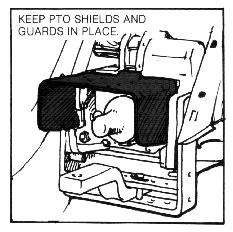
Use all required and available safety devices and driving skills when operating tractors on public roads. The risk is high! Roll-over protection, safety hitch, SMV emblem, rear-view mirrors, signal lights, hand signals, clearance lights and/or reflectors are all aids to safety on the highway. Make sure all loads are properly secured. Allow traffic to pass. Be considerate of others, and pull over to the shoulder when necessary. Keep your tractor and implements in your lane. If your equipment is wider than the traffic lane, keep it over on the shoulder. Avoid excessive speed, and drive defensively. Consult local or state officials for regulations on moving extra wide equipment on public roads.
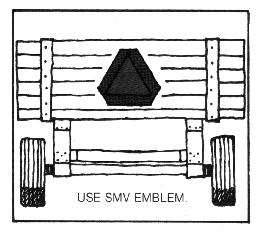
* No extra riders
Don't allow extra riders, and don't ask
to be an extra rider. Make this a firm
rule, and avoid a major cause of tractor
accidents. Tractors are designed only
for the drivers. Even in cabs, riders
have only limited protection, and they
may interfere with the tractor's
operation. The warning "hold tight" is
practically useless after the first minute
or two.
* Get on and off safely
Don't mount or dismount when tractor
is moving. Keep the mounting steps,
handholds, and operator platform clean
and dry. Do not jump from the tractor.
Set brakes if there is the slightest
chance of rolling.
* Stuck in hole
When stuck in a hole or soft spot, a
tractor can easily upset backwards
when the clutch is engaged. If power is
applied and wheels stick, the chassis
may revolve around the axle. When you
can't back out, get help!
* Hitch to the drawbar only
Never hitch to the axle or seat
bracket-you're inviting a backward
upset. Engage the clutch smoothly, and
avoid sudden acceleration.
* Use tractors only for jobs intended
Tractors are meant to be implement
carriers, transport units and remote
power sources. Tractors are not
designed for recreation, nor for use as
a tow truck or to run errands, herd
cattle, etc.
* Stay clear of ditches and embankments
Keep tractors and implements away
from ditch and embankment edges.
Edges may be undercut or weakened
and not be able to support the weight
of the equipment. Implements that slip
over the edge will tend to pull the
tractor with them.
* Loader accidents are common
Move and turn tractor at low speeds.
Keep load low while moving. Add rear
weight, and keep wheels wide. Lower
loader to the ground when parking or
servicing.
* Drive at a safe speed
When speed is doubled, the chance of
a side upset is four times as great.
Adjust speed to conditions.
* Operating on slopes and hillsides
Keep wheels spread as wide as
possible for the job-even when on
level ground. A tractor will overturn
sideways much more easily if the
wheels are close together. Watch for
rocks, humps, or holes which may
cause the tractor to tip. Make uphill
turns with caution, particularly with
tricycle-type tractors. Turn downhill if
stability becomes uncertain. Backward
upsets are apt to happen when
climbing hills, going forward out of a
ditch, or overloading the drawbar. If you
have to go up a steep slope, back the
tractor up the slope. Use a lower gear
when going downhill.
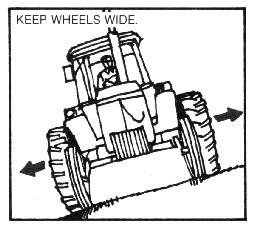
* Sharp turns cause upsets
High speed, rough ground, and narrow,
high-speed wheels greatly increase the
chance of upset, especially when
turning. Slow down before turning, and
avoid sharp turns if possible.
* Sharp turns and short hitches
Equipment can "ride" up on tractor tires
and cause a serious accident or
damage. Allow plenty of turning room,
especially when using duals or
extended wheels.
Knowing what to do and how to do it goes a long way to ensure safe tractor operation. Another vital factor is you. the operator. It is important to be in good physical and emotional condition when you are operating a tractor. If you are ill, tired, angry, emotionally upset, or if your mind is on something else, you could make a fatal mistake.
It is important, too, that you are comfortable enough while operating the tractor so that you can function well. If you are too cold or too hot, or the tractor noise level is too high, or the seat adjustment is incorrect, you will not operate the tractor as well as you would if you were comfortable. Discomfort is distracting, and it contributes to fatigue.
Short, frequent breaks will rest you better and faster than longer, less frequent ones. And, if you are exhausted, stop. You could save your life by doing so.
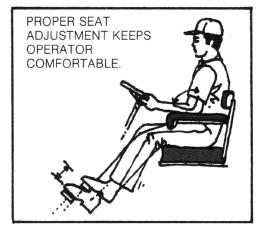
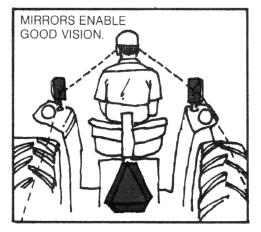
... a federal labor law affects you. Except when working for your parent or guardian on a farm owned or operated by that person, you are not permitted to operate a tractor over 20 pto-hp and certain other farm machinery (although these jobs can be started at age 14 with special 4-H or vo-ag training).
Persons under 14 may be employed to do any job that is not classified as particularly hazardous IF they have the written consent of their parents or guardians. There is one exception: those under 12 are not permitted to work on farms that used 500 or more man-days of farm labor during any quarter of the preceding calendar year.
Check with your county Extension office for up-to-date information.
RR 9/93
Cooperative Extension work in Agriculture and Home Economics, State of Indiana, Purdue University and U.S. Department of Agriculture cooperating: H.A. Wadsworth, Director, West Lafayette, IN. Issued in furtherance of the acts of May 8 and June 30, 1914. The Cooperative Extension Service of Purdue University is an equal opportunity/equal access institution.